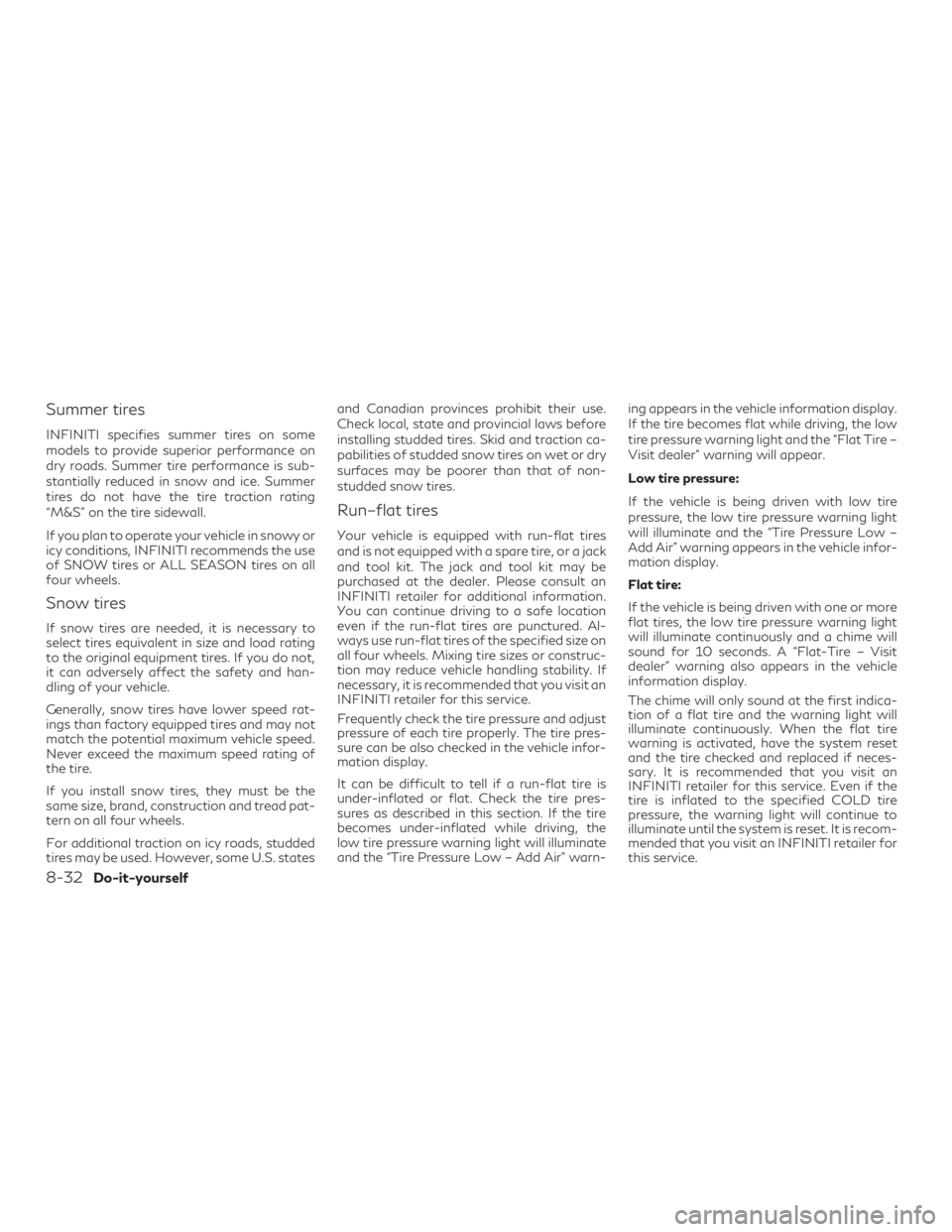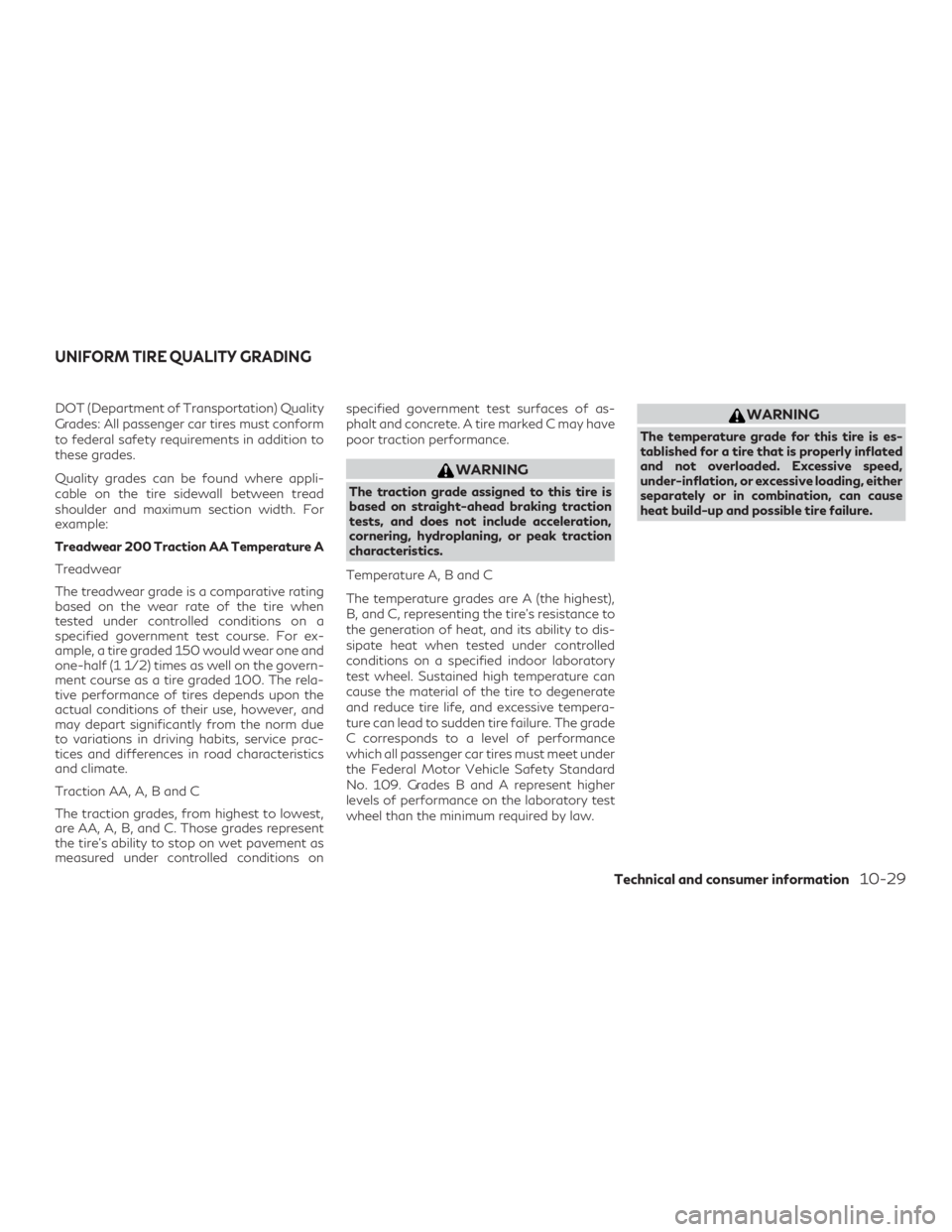Traction INFINITI QX50 2020 User Guide
[x] Cancel search | Manufacturer: INFINITI, Model Year: 2020, Model line: QX50, Model: INFINITI QX50 2020Pages: 580, PDF Size: 7.43 MB
Page 508 of 580

Summer tires
INFINITI specifies summer tires on some
models to provide superior performance on
dry roads. Summer tire performance is sub-
stantially reduced in snow and ice. Summer
tires do not have the tire traction rating
“M&S” on the tire sidewall.
If you plan to operate your vehicle in snowy or
icy conditions, INFINITI recommends the use
of SNOW tires or ALL SEASON tires on all
four wheels.
Snow tires
If snow tires are needed, it is necessary to
select tires equivalent in size and load rating
to the original equipment tires. If you do not,
it can adversely affect the safety and han-
dling of your vehicle.
Generally, snow tires have lower speed rat-
ings than factory equipped tires and may not
match the potential maximum vehicle speed.
Never exceed the maximum speed rating of
the tire.
If you install snow tires, they must be the
same size, brand, construction and tread pat-
tern on all four wheels.
For additional traction on icy roads, studded
tires may be used. However, some U.S. statesand Canadian provinces prohibit their use.
Check local, state and provincial laws before
installing studded tires. Skid and traction ca-
pabilities of studded snow tires on wet or dry
surfaces may be poorer than that of non-
studded snow tires.
Run–flat tires
Your vehicle is equipped with run-flat tires
and is not equipped with a spare tire, or a jack
and tool kit. The jack and tool kit may be
purchased at the dealer. Please consult an
INFINITI retailer for additional information.
You can continue driving to a safe location
even if the run-flat tires are punctured. Al-
ways use run-flat tires of the specified size on
all four wheels. Mixing tire sizes or construc-
tion may reduce vehicle handling stability. If
necessary, it is recommended that you visit an
INFINITI retailer for this service.
Frequently check the tire pressure and adjust
pressure of each tire properly. The tire pres-
sure can be also checked in the vehicle infor-
mation display.
It can be difficult to tell if a run-flat tire is
under-inflated or flat. Check the tire pres-
sures as described in this section. If the tire
becomes under-inflated while driving, the
low tire pressure warning light will illuminate
and the “Tire Pressure Low – Add Air” warn-
ing appears in the vehicle information display.
If the tire becomes flat while driving, the low
tire pressure warning light and the “Flat Tire –
Visit dealer" warning will appear.
Low tire pressure:
If the vehicle is being driven with low tire
pressure, the low tire pressure warning light
will illuminate and the “Tire Pressure Low –
Add Air” warning appears in the vehicle infor-
mation display.
Flat tire:
If the vehicle is being driven with one or more
flat tires, the low tire pressure warning light
will illuminate continuously and a chime will
sound for 10 seconds. A “Flat-Tire – Visit
dealer" warning also appears in the vehicle
information display.
The chime will only sound at the first indica-
tion of a flat tire and the warning light will
illuminate continuously. When the flat tire
warning is activated, have the system reset
and the tire checked and replaced if neces-
sary. It is recommended that you visit an
INFINITI retailer for this service. Even if the
tire is inflated to the specified COLD tire
pressure, the warning light will continue to
illuminate until the system is reset. It is recom-
mended that you visit an INFINITI retailer for
this service.
8-32Do-it-yourself
Page 510 of 580

TIRE CHAINS
CAUTION
Tire chains/cables should not be installed
on P255/45RF20 size tires. Installation of
the tire chains/cables on P255/45RF20
size tires will cause damage to the vehicle. If
you plan to use tire chains/cables, you
should install P235/55RF19 size tires on
your vehicle.
Use of tire chains may be prohibited accord-
ing to location. Check the local laws before
installing tire chains. When installing tire
chains, make sure they are the proper size for
the tires on your vehicle and are installed
according to the chain manufacturer’s sug-
gestions. Use only SAE class “S” chains. Class
“S” chains are used on vehicles with restricted
tire to vehicle clearance. Vehicles that can use
Class “S” chains are designed to meet the
minimum clearances between the tire and the
closest vehicle suspension or body compo-
nent required to accommodate the use of a
winter traction device (tire chains or cables).
The minimum clearances are determined us-
ing the factory equipped tire size. Other types
may damage your vehicle. Use chain tension-
ers when recommended by the tire chain
manufacturer to ensure a tight fit. Loose end
links of the tire chain must be secured or removed to prevent the possibility of whip-
ping action damage to the fenders or under-
body. If possible, avoid fully loading your ve-
hicle when using tire chains. In addition, drive
at a reduced speed. Otherwise, your vehicle
may be damaged and/or vehicle handling
and performance may be adversely affected.
Do not use tire chains on dry roads. Driving
with chains in such conditions can cause
damage to the various mechanisms of the
vehicle due to some overstress.
CHANGING WHEELS AND TIRES
Tire rotation
INFINITI recommends rotating the
tires every 7,500 miles (12,000 km).
For additional information on tire re-
placing procedures, refer to “Flat tire”
in the “In case of emergency” section
of this manual.
As soon as possible, tighten the wheel
nuts to the specified torque with a
torque wrench.
WDI0258
8-34Do-it-yourself
Page 549 of 580

CAUTION
If your vehicle is equipped with the Lifestyle
Receiver to avoid damage to your vehicle
do not tow a trailer with your vehicle.
Do not tow a trailer with your vehicle with the
Lifestyle Receiver (if so equipped). The Life-
style Receiver should be used for receiver-
mounted accessories only. The Lifestyle Re-
ceiver is designed for carrying bikes, snow
boards/skis, camping gear and various other
bulky items.
MAXIMUM LOAD LIMITS
Maximum trailer loads
Never allow the total trailer load to exceed
the value specified in the following Towing
Load/Specification Chart found in this sec-
tion. The total trailer load equals trailer
weight plus its cargo weight.
The maximum Gross Combined Weight Rat-
ing (GCWR) should not exceed the value
specified in the following Towing
Load/Specification Chart. The GCWR equals the combined weight of
the towing vehicle (including passengers and
cargo) plus the total trailer load. Towing
loads greater than these or using improper
towing equipment could adversely affect ve-
hicle handling, braking and performance.
The ability of your vehicle to tow a trailer is
not only related to the maximum trailer loads,
but also the places you plan to tow. Tow
weights appropriate for level highway driving
may have to be reduced for low traction situ-
ations (for example, on slippery boat ramps).Temperature conditions can also affect tow-
ing. For example, towing a heavy trailer in
high outside temperatures on graded roads
can affect engine performance and cause
overheating. The engine protection mode,
which helps reduce the chance of engine
damage, could activate and automatically
decrease engine power. Vehicle speed may
decrease under high load. Plan your trip care-
fully to account for trailer and vehicle load,
weather and road conditions.
WARNING
Overheating can result in reduced engine
power and vehicle speed. The reduced speed
may be lower than other traffic, which could
increase the chance of a collision. Be espe-
cially careful when driving. If the vehicle can-
not maintain a safe driving speed, pull to the
side of the road in a safe area. Allow the en-
gine to cool and return to normal operation.
For additional information, refer to “If your
vehicle overheats” in the “In case of emer-
gency” section of this manual.
CAUTION
Vehicle damage resulting from improper
towing procedures is not covered by
INFINITI warranties.
LTI2030
Technical and consumer information10-19
Page 559 of 580

DOT (Department of Transportation) Quality
Grades: All passenger car tires must conform
to federal safety requirements in addition to
these grades.
Quality grades can be found where appli-
cable on the tire sidewall between tread
shoulder and maximum section width. For
example:
Treadwear 200 Traction AA Temperature A
Treadwear
The treadwear grade is a comparative rating
based on the wear rate of the tire when
tested under controlled conditions on a
specified government test course. For ex-
ample, a tire graded 150 would wear one and
one-half (1 1/2) times as well on the govern-
ment course as a tire graded 100. The rela-
tive performance of tires depends upon the
actual conditions of their use, however, and
may depart significantly from the norm due
to variations in driving habits, service prac-
tices and differences in road characteristics
and climate.
Traction AA, A, B and C
The traction grades, from highest to lowest,
are AA, A, B, and C. Those grades represent
the tire’s ability to stop on wet pavement as
measured under controlled conditions onspecified government test surfaces of as-
phalt and concrete. A tire marked C may have
poor traction performance.
WARNING
The traction grade assigned to this tire is
based on straight-ahead braking traction
tests, and does not include acceleration,
cornering, hydroplaning, or peak traction
characteristics.
Temperature A, B and C
The temperature grades are A (the highest),
B, and C, representing the tire’s resistance to
the generation of heat, and its ability to dis-
sipate heat when tested under controlled
conditions on a specified indoor laboratory
test wheel. Sustained high temperature can
cause the material of the tire to degenerate
and reduce tire life, and excessive tempera-
ture can lead to sudden tire failure. The grade
C corresponds to a level of performance
which all passenger car tires must meet under
the Federal Motor Vehicle Safety Standard
No. 109. Grades B and A represent higher
levels of performance on the laboratory test
wheel than the minimum required by law.
WARNING
The temperature grade for this tire is es-
tablished for a tire that is properly inflated
and not overloaded. Excessive speed,
under-inflation, or excessive loading, either
separately or in combination, can cause
heat build-up and possible tire failure.
UNIFORM TIRE QUALITY GRADING
Technical and consumer information10-29